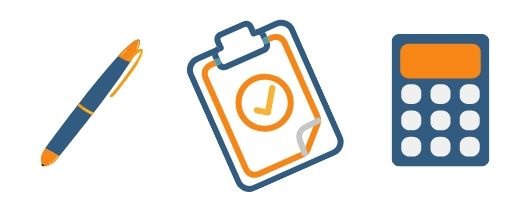
How to conduct a successful stocktake in 7 steps
A successful stocktake means a successful business. To be successful, a business needs to know where it is spending money, and making it. For a large number of SMEs, this means buying and selling stock.
An accurate stocktake that is reliable helps business owners to make a more informed decision when managing the business. While important for the business and your inventory records, it’s also vital when reporting to the ATO at tax time.
Ideally, you want to conduct a stocktake every month. If you wish, you can conduct them weekly or even daily if required.
Regular stocktakes will aid your purchasing decisions and help to reduce over-stocking items that don’t sell, otherwise known as stale stock. The more regular you can keep your schedule, the easier it will be to find variances and other issues.
What is a stocktake and why should you do them?
A stocktake is a means of accounting for all the inventory the business owns. It’s a chance to ensure that everything you have purchased can be valued for accounting purposes.
At any one time, there can be stock within the business that is and is not included in the inventory list.
It will generally fall into one of three categories:
- Stock that’s yet to be sold (is included)
- Stock that’s been sold, but not yet shipped (is not included)
- Stock that’s been purchased and delivered (is not included)
Any stock that is outside one of those three factors is considered a variance, as is stock that does not exist, and should be included. You still need to account for these items.
Minimising variance and finding the true value of your stock on hand is the real purpose of a stocktake. Variance means there is a problem with ordering, theft, or a mistake in the handling of your products.
It’s a good idea in most businesses to have two people counting an area. We’re all still human and we can make mistakes. Some businesses will have multiple people counting different sections, all coordinated by a supervisor, whose job is to keep everything sorted out and running smoothly.
A good stock inventory management solution for your business is a great start to achieving the best result every time you conduct a stocktake. Here’s seven steps to help you conduct a successful stocktake.

1. Identify where all the stock is located
Before you start counting, you need to know what it is you have to count. Using the three categories we highlighted above, make sure that each location you need to count has been identified and separated.
Invoiced goods for customers should be kept away from normal stock, as should stock that has been delivered and yet to be put into the inventory management system.
If you have multiple warehouses, make sure that each one is ready to be counted consecutively, or by other people at the same time.
It’s important that you try not to sell an item while a stocktake is taking place. This is why in general stocktakes are usually conducted outside of trading hours.
In Accentis Enterprise, a snapshot of the current stock levels is taken when you start a stocktake. It’s important not to sell anything until it has been counted, but once counted, any sales, or adjustments can be made, and will be balanced back to the snapshot.
2. Clean your stockroom and ensure inventory is neat and tidy
Counting multiple items scattered around everywhere is almost impossible. It will be hard to know what items have been counted and which ones haven’t.
Depending on your inventory coding system, now is the perfect time to make sure they’re all in the one place and sorted out logically.
When counting large quantities of any stock item, it’s helpful if someone can pre-count items into lots of 10, 50, 100 for example. If counting stock by weight, make sure scales are available and easily accessible.
Anything that can be done before recording the count is very useful, and saves mistakes being made later on. Ensure that all staff are aware that a stocktake is going to take place, and not to move any stock until confirmed.
3. Useful tools for a successful stocktake
There are many different tools that make a successful stocktake run smoothly.
Factors such as the stock items you have to count, the size of the items and quantity of them, can help you decide which tools are best for your business.
Pens or pencils
Manual stocktakes dictate that you will need to write the quantities down, usually on a stock item count sheet. When using pens, it’s a good idea to colour-coordinate.
The first counter uses a different colour to the second, and the third counter uses a different colour again. This allows for easy identification when a quantity has been recorded incorrectly, or to know who to ask if hand-writing is difficult to read.
Once signed off, it can be quick and easy to identify that stock item has been verified.
Clipboards
Sometimes a staff member might need to take a note, so include some blank pages on the clipboards. A clipboard gives the counter a solid surface to write on, which can minimise mistakes and keep hand-writing legible.
Clipboards are used mainly for manual stocktakes where there is a need for multiple count sheets to be left with stock items.
Calculators
If doing a manual stocktake with large quantities, a calculator can help to quickly add up the number of items counted, even if they’re sorted into bulk lots.
Some staff might be comfortable using their mobile phone, but if not, have some simple calculators on hand.
Stock Item Sheets
The inventory management system should be able to print out the entire stock item list, filtered in a number of ways. Some businesses will filter by stock code, others group by department and then by stock code, and others will filter by item code and then description.
Accentis Enterprise is powerful in this regard and can also filter by serial or batch numbers for a single stock item. This is helpful for manufacturers who produce batches of a single stock item and need to account for each batch quantity.
There’s no right or wrong way to filter your items, just use whatever is familiar to you.
Most stock item lists for a stocktake have the option to include the current stock on hand. This can be helpful for the stocktake supervisor, but should not be given to the counting staff. Reason being that, the stock on hand level may be incorrect, and lead to counters being lazy and not counting as well as they should.
When your system uses barcodes, ensure there is space for them on the sheets, and they are recorded correctly. If using barcodes for your stock, it’s more likely you’re using a handheld device anyway.
Hand-held scanners (mobile phones, PDE’s, scanners)
When your inventory is barcoded, it’s less likely there will be mistakes with recording data entry.
Staff should be aware of how to record items manually if a barcode is missing or damaged. This might be the case for still requiring manual Stock item sheets, or the mobile app might have a function allowing for manual search/entry.
If using hand-held scanners of any type, they will usually be wireless and could rely on other technology. Before the stocktake, ensure everything has been checked as working, batteries are charged, and staff know how to use them.
It’s a great idea to ensure the devices are protected in case they are dropped.
Warehouse or Stockroom Map
A great idea to coordinate a successful stocktake is to include a map of the area that’s being counted. More useful in a large area than if doing a stocktake on your own, it can be helpful nonetheless.
It can be a simple mud map quickly drawn up just before you start, or it can be a permanent fixture used in the stockroom for locating inventory quickly.
Sometimes a visual check of what’s been counted can help coordinate staff more effectively.

4. Reduce distractions for fewer errors
Performing a stocktake is a serious business function and this needs to be understood by all employees. Ensuring only employees who are conducting the stocktake are in the area is a great start.
If you don’t need to be there, don’t interrupt the people that do.
Another problem that has surfaced recently due to technology is the use of mobile phones. It’s not uncommon to require phones not to be used for the duration of a stocktake.
When staff are distracted, mistakes can easily occur. This will either affect the count, or make the stocktake take much longer than it should.
Some businesses will supply snacks and drinks throughout a stocktake to keep staff engaged in the task at hand.
5. Don’t estimate your inventory, make it count!
You don’t run your business by estimating costs, so don’t take shortcuts and you’ll have a sucessful stocktake. This is a serious business operation that needs commitment from start to finish.
Don’t count only the stock items you can see, as there might be more lurking underneath. Lift items and check that there is only one of them, and not two stuck together.
Open boxes and check quantities, as suppliers will also get it wrong from time to time.
The more accurate you are with your inventory now, the easier it is to spot mistakes later, and to plan better for your business in the future. See, know, grow your business.
6. Check for variances and do a recount if necessary
Once the count has been completed, you need to check for the variances. A variance can be over or under, and they both affect your stock valuation. The aim of the game is to get the number of variations to zero.
If you have more or less stock than you should have, find out the reason why.
Some of the common reasons stock will show a variance can be:
- Marked with an incorrect label
- Stored in multiple locations
- Not written off correctly
- Invoices have not yet been received
- Despatches have not been processed
- Counted multiple times
You need to check each and every line for any possible reason the stock is out of balance. Once you are satisfied that the count is correct, your variance will also be correct.
The unaccounted stock variance will be a cost to your business that is recorded.
To read more, check out our article How to Minimise Stock Variances which goes into more detail on variances in your business.

7. Update stock levels
Once you have counted the inventory twice or more, found all of the variances and are confident you have covered everything, it’s time to update your stock levels. This will be the new base of truth that your inventory system will use to record stock transactions against.
You can report on the current valuation of all stock currently in your database, and all information is available in your accounting software.
From here, you can make better business decisions based on the facts of what’s in stock, and what you need to order.
Conclusion for a Successful Stocktake
Running a successful stocktake takes time, planning, and dedication. On the whole, it is a pretty simple procedure that millions of businesses perform every day.
There are businesses that will have a simpler stocktake procedure than the one we have outlined here, depending on the products they sell, layout of their inventory, and size of the business.
It’s not uncommon for some business sectors to run a stocktake as often as every week. With a solid procedure in place of how your business will perform a stocktake, you can be sure that it will be successful.
Some businesses will have more complicated requirements for running a stocktake because they use batch tracking or serial tracking. Keep an eye out for a blog post covering how batch tracking can be easily maintained using our stock control system.
Accentis Enterprise has a full inventory management solution that is deeply integrated to other ERP modules. Creating, saving and sending data to other software tools is unnecessary as it’s contained within the one system.
If you want to read more on how an ERP system helps SMEs to grow, become more efficient and improve processes across the entire business, then download our free ERP eBook.
To learn more about Accentis Enterprise and what we can offer your business, contact us to arrange a chat.

Are you ready to make more money for your business?
Click here to start your journey today!
